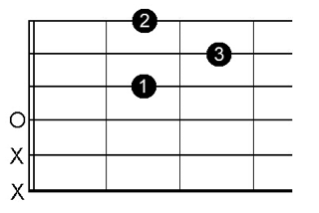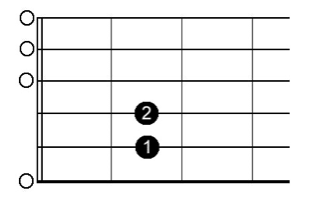2 Simple Ways To Get Creative With Your Open Chords
A common trend I see in lots of guitar players as they start out, is that once they’ve learned their open chords, they get bored and want to move onto something else (learn new chords in other positions on the neck, do some lead guitar, etc.) and generally want to move away from playing their open chords all the time.
Creating An Effective Warm Up Routine
I get that if it’s one’s goal to be a killer shred guitar player, then you obviously don’t want to be stuck playing open chords for too long – I sure wouldn’t want to be held back. That said, there are still many things you can do to spice up your open chords, and in this article, we’ll be looking at 2 of them. These are great for both beginners who are getting the hang of strumming and changing chords at the same time, and experienced players who want to spice up their rhythm playing without simply finding the next best chord to play.
1: Add Another Finger To The Chord
You might have noticed that in almost every open chord, you have at least one finger not being used (usually the pinky), and in some cases 2 fingers will be free. We can put that finger to good use by placing it in various spots of the fretboard to create new and exotic sounds within a basic chord.
Let’s look at an example of how we can do this with our D Major chord, pictured below:
In this case, pinky is free. If we put it on the high e string on the 3rd fret (now making your middle finger’s position obsolete) we now have a D Suspended 4th (Dsus4). If we put our 4th finger on the high e string on the 5th fret, we now have an extended version of a D5 chord – that’s 3 different chords that we can play by simply adding an extra finger! Pretty neat, don’t you think? ☺
Let’s look at another example – let’s take our E minor chord, pictured below:
A lot of players will know that if you add your ring finger onto the B string on the 3rd fret, you’ll create an E minor 7th (Em7). There’s way more that we can do though:
- If you put your ring finger on the G string at the 4th fret, you get extended E5 chord with the B note becoming prominent, since 2 strings are playing it at the same octave
- From there, if you add your pinky on the B string at the 5th fret, you get another extended E5 chord with the high E note being prominent, since 2 strings are playing it at the same octave
- From the original E minor, if you add the pinky again on the 5th fret of the B string, you get an E minor with that same prominent high E note
Those are just a few of our options. This concept can be applied to any chord where you have a free finger, and all it takes is placing that finger wherever you can, and seeing what new awesome sounds you can create with it!
2: Remove A Finger From The Chord
Just as we can tweak our open chords by adding extra fingers to it, we can also do that by removing our fingers as well. Again, this can apply to literally every chord we play.
If we and remove our index finger from our D Major, we now have a D Major Add 4th (Dadd4). If we put that finger back and then instead remove our middle finger (leaving an open high e string), we now have a D Suspended 2nd (Dsus2). If we put that finger back and then remove our ring finger (leaving an open B string) we now have a D6 chord. That’s 3 new interesting chords simply by removing one of our fingers!
Combine The Two
Now that you understand how both methods work, try experimenting with your open chords by adding and removing fingers from them, and make note of which new chords you really like. You can also combine these two methods together by switching between the different modifications you’ve discovered. As an exercise, try creating a chord progression that consists of nothing but variations of the same chord – you’ll be surprised at how cool this sounds, and how easy it is to do! A great example of this is “Lakeside Park” by Rush, which uses D5, Dsus4, D Major, and Dadd4 (among 2 other chords) in the same progression.
Overall, these concepts can breathe new life into your guitar playing, as the chords they create can often be used as substitutes for your regular open chords. This way, you’ll be able to grow as a guitar player and get more use out of everything you can play, instead of simply abandoning things that you spent so much time and effort into learning.
About The Author: Ryan Mueller is a guitar teacher and music school owner, dedicated to giving the best guitar lessons in Etobicoke.



